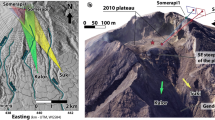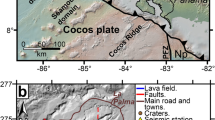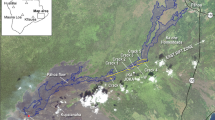Abstract
Effusion rate is a primary measurement used to judge the expected advance rate, length, and hazard potential of lava flows. At basaltic volcanoes, the rapid draining of lava stored in rootless shields and perched ponds can produce lava flows with much higher local effusion rates and advance velocities than would be expected based on the effusion rate at the vent. For several months in 2007–2008, lava stored in a series of perched ponds and rootless shields on Kīlauea Volcano, Hawai'i, was released episodically to produce fast-moving 'a'ā lava flows. Several of these lava flows approached Royal Gardens subdivision and threatened the safety of remaining residents. Using time-lapse image measurements, we show that the initial time-averaged discharge rate for one collapse-triggered lava flow was approximately eight times greater than the effusion rate at the vent. Though short-lived, the collapse-triggered 'a'ā lava flows had average advance rates approximately 45 times greater than that of the pāhoehoe flow field from which they were sourced. The high advance rates of the collapse-triggered lava flows demonstrates that recognition of lava accumulating in ponds and shields, which may be stored in a cryptic manner, is vital for accurately assessing short-term hazards at basaltic volcanoes.







Similar content being viewed by others
References
Bailey JE, Harris AJL, Dehn J, Calvari S, Rowland SK (2006) The changing morphology of an open lava channel on Mt. Etna. Bull Volcanol 68:497–515
Calvari S, Spampinato L, Lodato L, Harris AJL, Patrick MR, Dehn J, Burton MR, Andronico D (2005) Chronology and complex volcanic processes during the 2002–2003 flank eruption at Stromboli volcano (Italy) reconstructed from direct observations and surveys with a handheld thermal camera. J Geophys Res 110:B02201. doi:10.1029/2004JB003129
Hamaguchi H, Nishimura T, Zana N (1992) Process of the 1977 Nyiragongo eruption inferred from the analysis of long-period earthquakes and volcanic tremors. Tectonophys 209:241–254
Harris AJL, Dehn J, Calvari C (2007) Lava effusion rate definition and measurement: a review. Bull Volcanol 70(1):1–22
Heliker C, Mattox TN (2003) The first two decades of the Pu'u 'Ō'ō–Kupaianaha eruption: Chronology and selected bibliography. In: Heliker C, Swanson DA, Takahashi TJ (eds) The Pu'u 'Ō'ō–Kupaianaha eruption of Kīlauea Volcano, Hawai'i: the first 20 years. US Geol Surv Prof Pap 1676:1–27
Heliker C, Wright TL (1991) The Pu'u 'Ō'ō–Kupaianaha eruption of Kīlauea. EOS Trans AGU 72(47):521,526,530
Hon KA, Kauahikaua JP, Denlinger RP, Mackay K (1994) Emplacement and inflation of pahoehoe sheet flows; observations and measurements of active lava flows on Kilauea Volcano, Hawaii. Geol Soc Am Bull 106(3):351–370
Kauahikaua J (2007) Lava flow hazard assessment, as of August 2007, for Kīlauea East Rift Zone eruptions, Hawai'i Island. US Geol Surv Open-File Rep 2007–1264
Kauahikaua J, Sherrod DR, Cashman KV, Heliker C, Hon K, Mattox TN, Johnson JA (2003) Hawaiian lava-flow dynamics during the Pu'u 'Ō'ō-Kupaianaha eruption: a tale of two decades. In: Heliker C, Swanson DA, Takahashi TJ (eds) the Pu'u 'Ō'ō–Kupaianaha eruption of Kīlauea Volcano, Hawai'i: the first 20 years. US Geol Surv Prof Pap 1676:63–87
Lipman PW, Banks NG (1987) A'a flow dynamics, Mauna Loa, 1984. In: Decker RW, Wright TL, Stauffer PH (eds) Hawaiian volcanism. US Geol Surv Prof Pap 1350:1527–1568
Orr T, Hoblitt RP (2008) A versatile time-lapse camera system developed by the Hawaiian Volcano Observatory for use at Kīlauea Volcano, Hawai'i. US Geol Surv Sci Invest Rep 2008–5117
Patrick MR, Orr T, Wilson D, Dow D, Freeman R (2011) Cyclic spattering, seismic tremor and surface fluctuation in a perched lava channel, Kilauea Volcano. Bull Volcanol. doi:10.1007/s00445-010-0431-2
Peterson DW, Tilling RI (1980) Transition of basaltic lava from pahoehoe to aa, Kilauea volcano, Hawaii: field observations and key factors. J Volcanol Geotherm Res 7:271–293
Pieri DC, Baloga SM (1986) Eruption rate, area, and length relationships for some Hawaiian lava flows. J Volcanol Geotherm Res 30:29–45
Pinkerton H, Sparks RSJ (1976) The 1975 sub-terminal lavas, Mount Etna: a case history of the formation of a compound lava field. J Volcanol Geotherm Res 1:167–182
Pinkerton H, Wilson L (1994) Factors controlling the lengths of channel-fed lava flows. Bull Volcanol 56:108–120
Poland M, Miklius A, Orr T, Sutton J, Thornber C, Wilson D (2008) New episodes of volcanism at Kīlauea Volcano, Hawai'i. EOS Trans AGU 89:37–38
Rowland S, Munro DC (1993) The 1919–1920 eruption of Mauna Iki, Kilauea: chronology, geologic mapping and magma transport mechanisms. Bull Volcanol 55(3):190–203
Rowland S, Walker GPL (1987) Toothpaste lava: characteristics and origin of a lava structural type transitional between pahoehoe and aa. Bull Volcanol 49(4):631–641
Rowland S, Walker GPL (1990) Pahoehoe and aa in Hawaii: volumetric flow rate controls the lava structure. Bull Volcanol 52(8):615–628
Smithsonian Institution (1977) Nyiragongo. Scientific Event Alert Network (SEAN) Bulletin 2(3)
Sutton AJ, Elias T, Kauahikaua J (2003) Lava effusion rates for the Pu'u 'Ō'ō–Kupaianaha eruption derived from SO2 emissions and Very Low Frequency (VLF) measurements. In: Heliker C, Swanson DA, Takahashi TJ (eds) The Pu'u 'Ō'ō–Kupaianaha eruption of Kīlauea Volcano, Hawai'i: the first 20 years. US Geol Surv Prof Pap 1676:137–148
Tazieff H (1977) An exceptional eruption: Mt. Niragongo, Jan. 10th, 1977. Bull Volcanol 40(3):189–200
Wadge G (1978) Effusion rate and the shape of aa lava flow-fields on Mount Etna. Geology 6:503–506
Walker GPL (1973) Lengths of lava flows. Phil Trans R Roc Lond 274:107–118
Walker GPL (1991) Structure, and origin by injection of lava under surface crust, of tumuli, “lava rises”, “lava-rise pits”, and “lava-inflation clefts” in Hawaii. Bull Volcanol 53:546–558
Wentworth CK, Macdonald GA (1953) Structures and forms of basaltic rocks in Hawaii. U.S. Geol Surv Bull 994, 98 pp
Wolfe EW, Garcia MO, Jackson DB, Koyanagi RY, Neal CA, Okamura AT (1987) The Puu Oo eruption of Kilauea Volcano, episodes 1–20, January 3, 1983, to June 8, 1984. US Geol Surv Prof Pap 1350:471–508
Acknowledgments
We thank Andrew Harris, who suggested contrasting local effusion rate with longer-term supply rate at the vent and Scott Rowland, who discussed toothpaste lava and seeps. From HVO, Jim Kauahikaua provided helpful reviews, Kelly Wooten contributed to field observations and time-lapse image analysis, David Wilson provided seismic analysis, and Jeff Sutton provided data on gas emissions. David Okita piloted our weekly helicopter flights, provided invaluable observations and discussion, and helped us recognize the nature of the rootless shields. Reviews by D. Sherrod, R. McGimsey, S. Calvari, M. James, and J. McPhie improved the paper and are gratefully acknowledged.
Author information
Authors and Affiliations
Corresponding author
Additional information
Editorial responsibility: J. McPhie
Rights and permissions
About this article
Cite this article
Patrick, M.R., Orr, T.R. Rootless shield and perched lava pond collapses at Kīlauea Volcano, Hawai'i. Bull Volcanol 74, 67–78 (2012). https://doi.org/10.1007/s00445-011-0505-9
Received:
Accepted:
Published:
Issue Date:
DOI: https://doi.org/10.1007/s00445-011-0505-9




